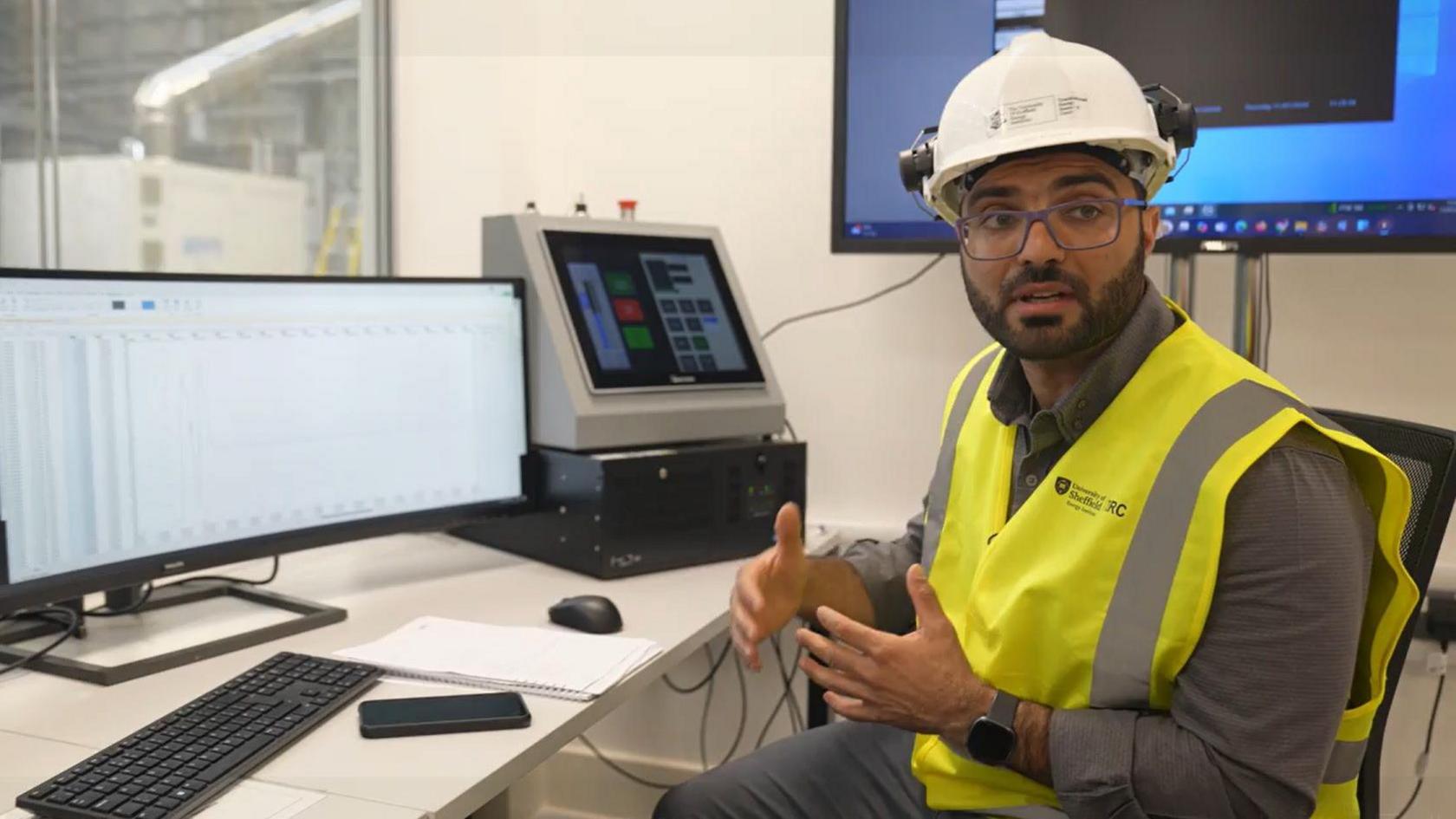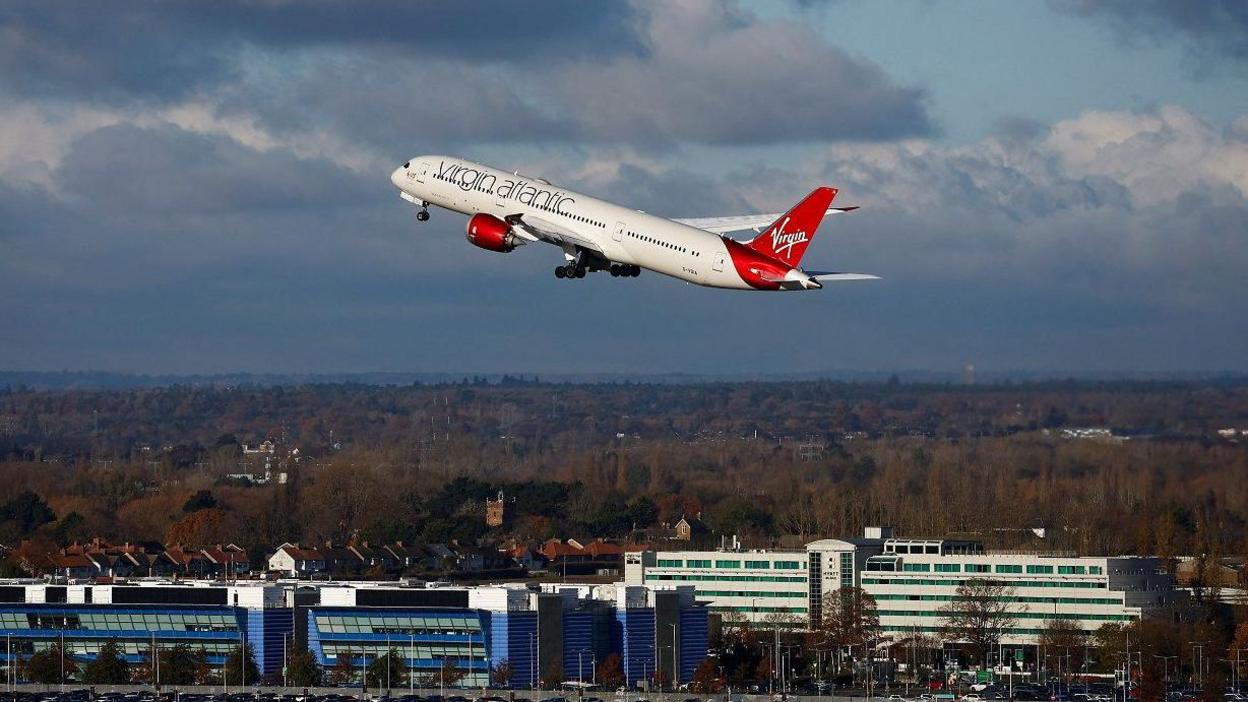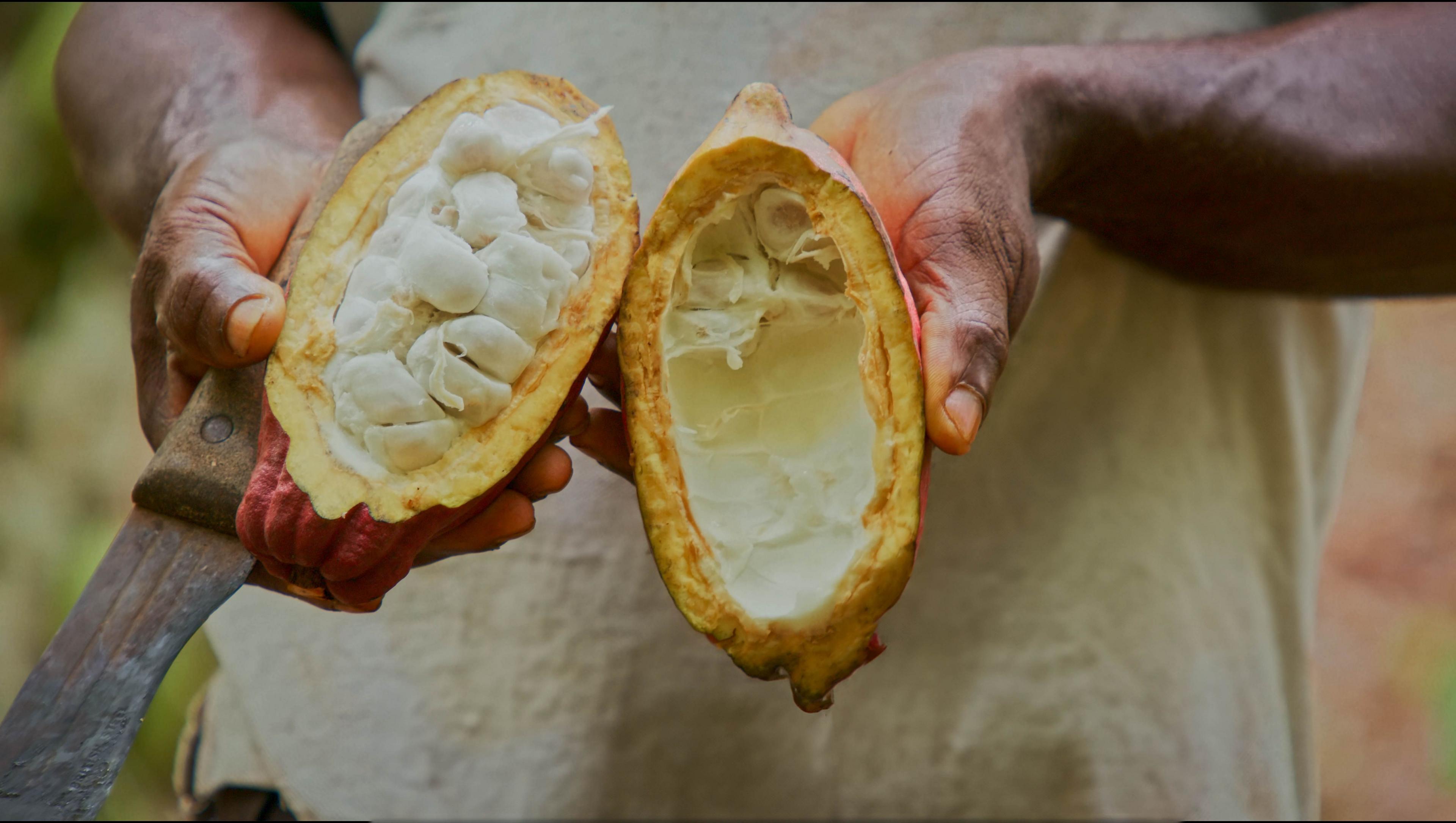Will sustainable aviation fuels take off?

Ihab Amed working on the test jet engine
- Published
In a building on the edge of a business park outside Sheffield, researcher Ihab Ahmed is preparing to fire up a small jet engine.
Originally used as an auxiliary power unit for a commercial airliner, it has been turned into a testbed for new fuels developed in a laboratory next door.
The arrangement is a centrepiece of Sheffield University’s Sustainable Fuels Innovation Centre (SAF-IC), a research facility set up to allow synthetic fuels to be prepared and evaluated on a small scale, before being put into large scale production.
On a bank of computer screens in a nearby control room, Ihab can monitor the engine as it starts with a burst of flame and powers up.
Sensors tell him what the engine is doing in real time – and allow the exhaust gases to be continually analysed.
Sustainable aviation fuels (or SAF) are synthetic alternatives to fossil fuels, made from renewable sources.
These can include waste cooking oils, vegetable fats and agricultural waste, as well as captured carbon dioxide.
The advantage of burning fuels like these is that it does not add to the overall load of carbon dioxide in the atmosphere.
The carbon emitted has only recently been removed, either by plants or by chemical processes. By contrast, burning fossil fuels releases carbon that has been stored in the earth for millions of years.
“From an environmental perspective, it’s day and night," Mr Ahmed explains.
“In principle, the CO2 should be a net zero, so there is no more carbon dioxide added to the atmosphere, but another benefit is the non-CO2 part of things.
“For example, it reduces the particulates or smoke that comes out of the engine, which can affect your lungs, as well as contributing to the creation of contrails."
In practice, sustainable fuels are not carbon neutral, because of the energy used in producing, refining and transporting them. The actual reductions vary widely depending on the fuel used.

Using a test jet engine Ihab Amed analyses how sustainable aviation fuels perform
The aviation industry is under pressure to find an alternative to jet fuel.
According to forecasts from both Airbus and Boeing, the global airliner fleet is expected to more than double over the next two decades, as the middle classes in countries like India and China expand, and demand for air travel increases.
At the same time, members of the International Air Transport Association, which represents airlines, have committed to reaching net zero by 2050.
Some gains will be made by replacing older planes with new ones. The most modern aircraft are between 15 and 30% more fuel efficient than their predecessors. Yet if the industry is to continue expanding, much more will be needed.
In the longer term, new technologies such as hydrogen power and electrification are likely to play a role, at least on shorter routes. But there are steep challenges to overcome.
Hydrogen, for example, is bulky and difficult to store in large quantities. It either needs to be kept as a highly compressed gas or as a very cold liquid. To be sustainable, it has to be made in a "clean" way, from renewable sources – and supplies now are very limited.
“We believe we could bring a small hydrogen fuel cell aircraft to the market between 2035 and 2045, technically,” says Arjen Meijer, chief executive of the Brazilian jet maker Embraer.
“But the question that needs to be answered is: will there be sufficient hydrogen to feed those aircraft? These things need to come together. They can’t happen separately."
Batteries, meanwhile, are currently very heavy in relation to the energy they contain. This makes them unsuitable for powering large planes, or being used over long distances.
This means that hydrogen and hybrid, or fully electric, planes remain years away. Sustainable aviation fuels, by contrast, can be made in the lab to have the same characteristics as conventional ones derived from crude oil, so they can be used in today’s aircraft.

Last year Virgin Atlantic powered a transatlantic flight using 100% SAF
There are restrictions. Airlines must currently use a blend of SAF with ordinary fuel, with the SAF component not exceeding 50%.
However, modern planes are capable of burning 100% SAF. In a specially approved test flight last year, Virgin Atlantic flew a Boeing 787 from London to New York using fuel exclusively produced from waste fats and plant sugars.
“The technologies are already available and certified for use in aircraft," explains Julie Kitcher, chief sustainability officer at Airbus.
“The challenge with sustainable fuels is really about getting it produced at scale, across the globe, because this is a global industry, at an affordable price.”
And that is very clearly the catch. Supplies of SAF are currently minimal. According to the European regulator EASA, they make up just 0.05% of the fuel used in the EU. They also cost between three and five times as much as "regular" jet fuel.
Governments want to change this. In the UK a "SAF mandate" has been introduced, which stipulates that from next year, 2% of all jet fuel supplied must be SAF, increasing to 10% in 2030 and 22% in 2040.
The EU has a similar mandate, although it extends to 2050 – when the target for SAF use will be 63%. The US does not have minimum requirements but offers subsidies to bring down the price of sustainable fuels.
But if SAF usage is to increase, production will also need to be ramped up dramatically.

British firm Firefly is making aviation fuel from human waste
There are many different methods, or pathways for making sustainable fuels. They can be made from biomass, such as waste cooking oil, energy crops, wood, agricultural residues and even human waste.
However, there are concerns that this will not provide all the fuel the market will ultimately need. Some feedstocks may need to be avoided, either to prevent environmental degradation such as deforestation, or to prevent land needed for growing food from being turned over to energy production.
An alternative is to use a method called power to liquid, in which water and carbon dioxide are broken down, with the resulting carbon and hydrogen combined to create liquid fuel.
This could produce potentially limitless supplies of fuel, but in order to be sustainable would require large quantities of renewable electricity, as well as a substantial increase in carbon capture and storage.
Both processes – using biomass or power to liquid - are currently very expensive. As a result, the aviation industry is demanding action to increase production, and bring prices down through economies of scale.
However, environmentalists question whether this is actually viable.
"There are good SAFs, and there are bad SAFs, but the brutal truth is that right now there is not much of either,” says Matt Finch, UK head of campaign group Transport & Environment.
“Conversely, right now there are thousands of new planes on order from airlines, and all of them will burn fossil fuels for at least 20 years.
"Actions speak louder than words, and it's clear that the aviation sector has no plans to wean itself off its addiction to pollution."
Nonetheless, at the recent Farnborough Airshow, there were several significant announcements relating to SAF.
A consortium including Airbus, AirFrance-KLM, Associated Energy Group, BNP Paribas and Qantas among others announced plans to invest $200m (£151m) in a new fund which will invest in “technologically mature SAF-producing projects using for instance waste-based feedstocks”.
Meanwhile Boeing said it had set up a partnership with the investment company Clear Sky to promote a method of producing SAF pioneered by the British company Firefly.
That method involves taking human waste and using heat and high pressure to turn it into a substance which can then be used to make SAF.
In other words, it allows planes to be powered by poo.
Clarification 20 September 2024: This article was amended to include further information about the CO2 impact of producing, refining and transporting sustainable fuels.

Sign up for our Future Earth newsletter to get exclusive insight on the latest climate and environment news from the BBC's Climate Editor Justin Rowlatt, delivered to your inbox every week. Outside the UK? Sign up to our international newsletter here.
More Technology of Business
- Published27 August 2024

- Published20 August 2024
- Published13 August 2024
